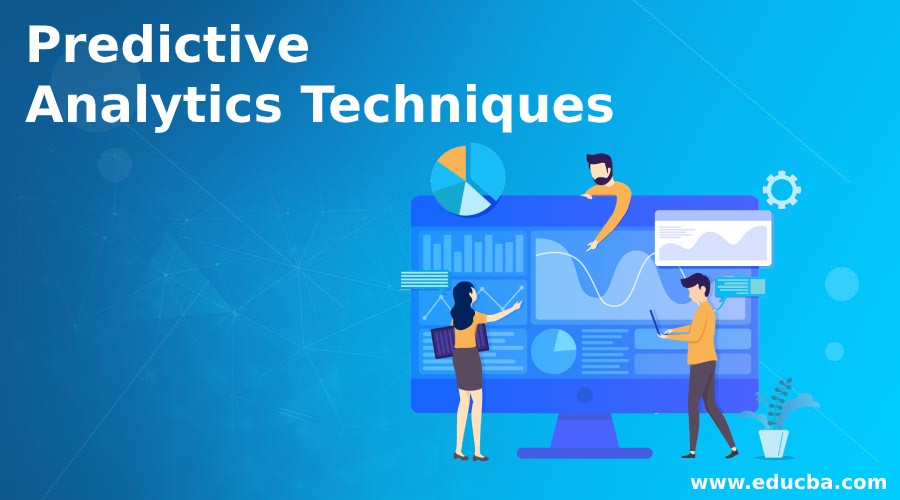Updated May 15, 2023

Introduction to Predictive Analytics Techniques
The following article provides an outline for Predictive Analytics Techniques. Predictive Analytics uses big and varied data from various sources to determine or predict future outcomes based on Historical and current trends or data. It involves big Data techniques to process large volumes of data to ascertain future outcomes. It takes multiple techniques and methods from Data Mining, Statistics, Predictive Modelling, etc. By successfully applying Predictive Analytics, Businesses can benefit immensely by interpreting big data to their advantage.
Examples of structured data include Age, Gender, Location, Income, etc. On the other hand, unstructured data is unorganized and not formatted, usually found in text-heavy or image processing. Predictive Analytics using concepts of Data mining, Statistics, and Text Analytics can easily interpret such structured and Unstructured Data. Predictive Analytics typically involves a 7 Step process, viz., Defining the Project, Data Collection, Data Analysis, Statistics, Modelling, Model Deployment, and Model Monitoring.
Several Predictive Analytics Techniques
Predictive analytics uses a number of different methodologies, and organizations typically combine these techniques to forecast outcomes.
Techniques can be broadly divided into two categories: regression and machine learning.
1. Regression Techniques
Regression techniques are the mainstay of Predictive Models. They are a set of Statistical processes for estimating the relationship between a dependent variable and one or more independent Variables. It focuses on establishing a mathematical equation to represent interactions between different variables. Stock Market Analysts also use Regression Models to determine how factors like Interest Rates would affect Stock prices.
The most common Regression Models used for Predictive Analytics are:
- Linear Regression Model: One of the most widely used modeling techniques. In this technique, the dependent variable is continuous, the Independent variables can be straight or discrete, and the nature of regression is linear. One of the more critical things to know is Linear based Regression models is the inclusion of outliers as variables as they affect the estimates and the regression lines, thereby affecting the outcome grossly, which can misrepresent the model entirely.
- Logistic Regression: We can use this model when the dependent variable is binary (Yes/No) in nature. There’s no need for a linear relationship between the variables like Linear Model. Therefore, it can handle various connections by applying a Nonlinear log to predict the odds ratio. Also, it requires a large sample size to est mimic future outcomes. Ordinal Logistic Regression is used when the dependent variable is ordinal, while Multinomial Logistic Regression is used when the dependent variable is multiclass.
- Time Series Models: Time series models are an effective tool for predicting the future behavior of variables based on historical data. To model time series, a stochastic process Y(t) is used, which is a sequence of random variables. Depending on frequencies, a time series can be yearly (Annual budgets), quarterly (Sales), Monthly (Expenses), or Daily (Stock Prices). Suppose you use only previous values of the time series to predict its future importance. In these circumstances, the term used is univariate time series forecasting, whereas multivariate time series forecasting is used when exogenous variables are used. Python programmers can utilise the most popular time series model, known as ARIMA (AutoRegressive Integrated Moving Average), to make predictions about the future.
2. Machine Learning Techniques
Machine Learning involves developing techniques that enable computers to learn, and it is a branch of Artificial Intelligence (AI). It employs advanced statistical methods and regression and classification techniques.
Some of the Predictive techniques using Machine learning are:
- Neural Networks: It’s used when the exact relationship between the input variable and output has yet to be discovered. Their key feature, as discussed, is that they learn from their behavior through training. Some examples of neural networks are backpropagation, quick propagation, conjugate gradient descent, projector operator, etc.
- MLP: Multilayer Perceptron or MLP is a deep, Artificial Neural Network with more than one perceptron. They have an input layer to receive the signal and an output layer that makes a decision or prediction about the input variable. Between these two layers, an arbitrary number of hidden layers are the computational engines that drive the system.
- Naive Bayes: Naive Bayes algorithm is a classification technique based on the Bayes theorem. Naive Bayes theorem is a robust algorithm for the classification problem. The Naive Bayes model has three types: the Gaussian model, which predicts from normally distributed features; the Bernoulli model, which is used to predict from binary features; and the Multinomial model, which is used when features describe discrete frequency counts like word count.
Conclusion
Since it has several use cases in every field imaginable, learning tools of Predictive Analytics are imperative for anyone looking for a career in Data Science or Business Analytics in particular. Moreover, with the increasing availability of data, we can predict future outcomes with greater precision. This enables businesses and Institutions to make informed decisions.
Recommended Articles
We hope that this EDUCBA information on “Predictive Analytics Techniques” was beneficial to you. You can view EDUCBA’s recommended articles for more information.

